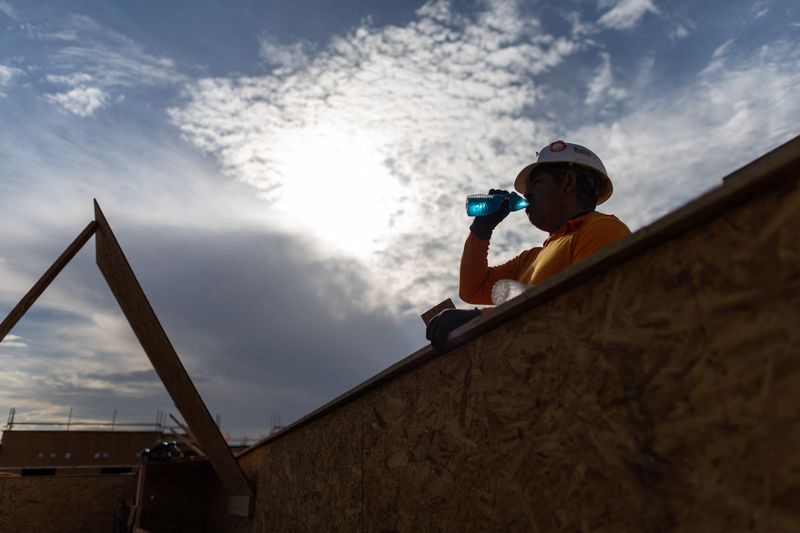
© Reuters. A construction worker drink a cold beverage during a heat wave where temperatures rise over 110 degrees Fahrenheit for 27 consecutive days, in Scottsdale, at the Phoenix metro area, Arizona, U.S., July 28, 2023. REUTERS/Carlos Barria
By Safiyah Riddle
(Reuters) – Record-breaking heat waves across the U.S. forced small businesses to close early in July, according to a report released on Tuesday, and reduced paid working hours for employees as dangerous temperatures reshape consumer behavior.
Hundreds of millions Americans dealt with extreme heat advisories in the past two weeks, as temperatures across the South and Southwest hit historic highs. These hazardous conditions have kept consumers inside and forced small businesses to close early – cutting into paid hours for employees – according to a report by the small business payroll company Homebase.
Nationally, small business employees worked 0.9% fewer hours in the first two weeks of July compared with the last two weeks of June – a standard seasonal change that is typical of summer months – the report said. But slowdowns were up to five-and-a-half times higher in cities that experienced the worst of the heat wave, highlighting the impact of high temperatures on local economies.
Small business employees in New Orleans and Memphis, for example, were on the clock 5.7% and 5.1% less, respectively, than they were in June as business owners shorten hours to adjust for fewer customers and try to protect employees from too much heat exposure. Memphis clocked 11 days with temperatures at 90 degrees Fahrenheit (32 degrees Celsius) or above in July, while New Orleans recorded 26 days in the 90s.
By contrast, businesses in cities that experienced shorter heat waves were able to increase hours of operation and the number of employees working: Boston – with just two days in the 90s – saw the largest month-to-month increase in the number of hours worked by employees at 7.8%.
“Main Street is feeling the heat. It may just be too hot for customers and businesses alike,” said Homebase CEO John Waldmann.
Danah Lee saw it firsthand as an employee at Willie’s Taco Joint in Phoenix – where earlier in July the National Weather Service recorded the longest consecutive streak of temperatures over 110 degrees Fahrenheit in history. Lee said there has been a significant decrease in foot traffic and the indoor dining areas consistently reach 95 degrees or above, despite the restaurant’s best efforts to keep things cool.
“Not only is it affecting our business, but it’s affecting my team. Working long hours in this heat is very hard. I’ve had to have more people on my schedule, working shorter shifts to make sure we have no heat exhaustion,” said Lee.
Some employers in labor intensive outdoor industries are electing to shift workers’ hours earlier in the day while temperatures are relatively lower rather than cutting them altogether, according to Travis Parsons (NYSE:), director of occupational safety and health for Laborers International Union of North America, which represents half a million builders and construction workers across the U.S. and Canada.
But Parsons said the lack of federal oversight meant that contractors were not obliged to make these accommodations in some states, leaving workers vulnerable to heat-related injuries.
“It’s more relevant now than ever. It’s always been an issue in my 20 plus years, but it seems to be really in the spotlight,” said Parsons. “It’s very concerning.”








